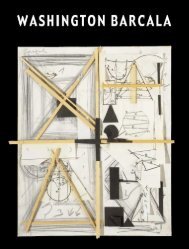VERSIÓN INGLESA ENGLISH VERSION - Fundación César Manrique
VERSIÓN INGLESA ENGLISH VERSION - Fundación César Manrique
VERSIÓN INGLESA ENGLISH VERSION - Fundación César Manrique
Create successful ePaper yourself
Turn your PDF publications into a flip-book with our unique Google optimized e-Paper software.
162<br />
substantial number of centres appeared across the entire Spanish geography, including the I.V.A.M. at<br />
Valencia, the C.A.A.M. at Las Palmas de Gran Canaria, the C.G.A.C. at Santiago de Compostela, the<br />
M.A.C.B.A. at Barcelona, The Guggenheim Museum at Bilbao, and the revitalised Museum of Fine Art<br />
in the same city. This artistic decentralisation radically changed the balance of power in which Spanish<br />
art had developed throughout the century, bringing the situation in Spain into line with the model<br />
prevailing in developed western countries. There was also a mass response on the part of the public<br />
to this new activity, with exhibitions and other events often attracting an overwhelming turnout.<br />
Although the optimism that may be drawn from the foregoing should not conceal the fact that all<br />
these events were subject to severe limitations and shortcomings 26 , there can be no doubt that the<br />
situation in the nineties could hardly have been more different from the circumstances prevailing<br />
when <strong>César</strong> <strong>Manrique</strong> began his career in Lanzarote in 1939.<br />
26. Fusi, Juan Pablo: “Cultura y democracia. La cultura de la<br />
transición”, in Un siglo de España. La cultura. Madrid, Marcial<br />
Pons, 1999, p. 149 et sequentes.
















![Becas y premios de la Fundación César Manrique [1997-2006]](https://img.yumpu.com/20766851/1/184x260/becas-y-premios-de-la-fundacion-cesar-manrique-1997-2006.jpg?quality=85)
